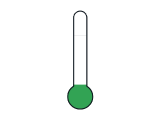
Dairy cows & dry cows
Did you know that a low somatic cell count in winter/spring helps avoid exceeding the maximum tank somatic cell count during heat stress?
Keep an eye on the forecast, be prepared for warmer periods:
- Check the performance of your barn ventilation: Install fans in the barn to improve the barn climate. Especially above the feed fence, fans are a great solution, especially if there is extreme heat. Don't forget to properly ventilate dry cows and the waiting area!
- Add a heating inhibitor and possibly a buffer and/or live yeast in the ration
- Get your cows used to changes in your feed management in advance
- Provide sufficient and clean drinking water and places at all times
- Make sure all animals have a place to eat (>85cm per animal place)
Calves
Did you know that shearing can not only prevent heat stress but also help with fly control?
Keep an eye on the forecast, be prepared for warmer periods:
- Ensure adequate and clean drinking water at all times.
- Shave calves' backs if necessary to prevent sweating.
- Make sure you stock a suitable electrolyte product if, for example, Sprayfo Osmofit
Stay ahead of heat stress
Receive valuable insights in your inbox
Ready to learn more about how to combat heat stress in your dairy herd over the course of the summer months? Fill out the form below with your first name, last name, and email address to receive valuable information and tips directly to your inbox. Stay ahead of the heat and keep your cows healthy and productive!



